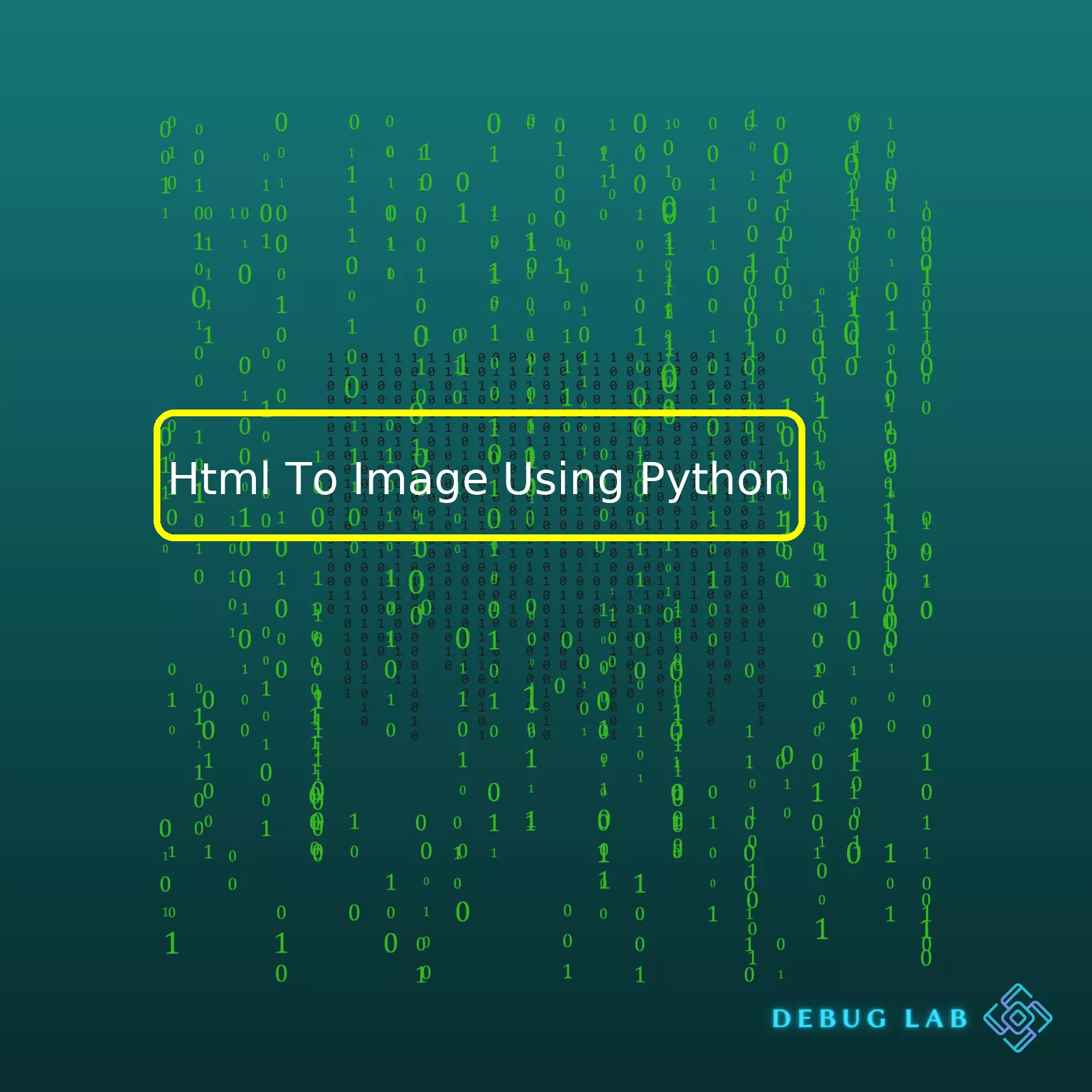
For instance, consider the following code snippet using ‘imgkit’.
import imgkit
config = imgkit.config(wkhtmltoimage='/path/to/wkhtmltoimage')
imgkit.from_file('test.html', 'out.jpg', config=config)
What this code does is it first imports the ‘imgkit’ library, then defines its path and finally converts an HTML file named ‘test.html’ into an image ‘out.jpg’. Remarkable, isn’t it? Now wouldn’t it be nice if we could summarize this topic – ‘HTML To Image Using Python’, in a table? Absolutely, yes!
So, let’s dive into it right away:
| Python Library | Description |
|---|---|
| imgkit | A Python wrapper for wkhtmltoimage, aimed at converting html to image. |
| wkhtmltoimage | An open source tool that imgkit uses internally to execute the image conversion from HTML. |
Looking at this nifty little table, we can see how these two are interconnected. ‘imgkit’, being a Python wrapper, leverages another open source tool called ‘wkhtmltoimage’ which performs the actual conversion, thereby fulfilling our task of changing HTML to Image.
Let’s not overlook the fact that Python was engineered with simplicity as its foremost priority. As evident from the code snippet, one hardly needs much effort to grasp the utility of the ‘imgkit’ library. It perfectly embodies the ease and versatility that Python provides to its user base, truly establishing its place amongst the top coding languages.
In this era of digital transformation, showcasing data or any form of content in different formats has become paramount. Thus, having the ability to convert HTML to image could come extremely handy in scenarios like taking screenshots of web pages, sharing information on social media, rendering HTML outputs in a more presentable format, etc.
To wrap up, the ‘imgkit’ Python library truly brings out the beauty and prowess of Python programming language in the arena of HTML to Image conversion and gives coders an efficient tool to work with.
Reference:
[Imgkit Github Documentation](https://github.com/jarrekk/imgkit)The Python ecosystem offers various libraries for web scraping, data analysis, artificial intelligence, and more. Among these libraries, we have certain powerful tools that help us convert HTML to Image directly. One such library is the “Imgkit” library in Python. Boasting a variety of features and ease of use, Imgkit can be leveraged effectively to take screenshots of web pages or convert HTML code to an image.
Let’s delve into how one can use the Imgkit python library to convert HTML to an image:
imgkit
Python package using pip, you’d enter the following commands:
sudo apt-get install wkhtmltopdf pip install imgkit
Here’s an example of how you can capture a complete webpage and store it as an image.
import imgkit
imgkit.from_url('http://google.com', 'out.jpg')
In this case, the function
from_url()
takes two parameters: the URL of the webpage and name of the output file. The output is saved in jpg format.
If you wish to convert a local html file to an image, you’d input:
imgkit.from_file('/path/to/local/file.htm', 'out.jpg')
This function,
from_file()
, also takes two arguments: the local file path and the output file’s name. The result will again, be saved as a .jpg file.
To transform a string containing HTML to an image, refer to the below script:
imgkit.from_string('Hello!', 'out.jpg')
This time, the function
from_string()
is responsible for the conversion. It accepts two inputs: a string containing HTML and the name of the output file.
One critical aspect while working with ‘ImgKit’ and its parent utility ‘wkhtmltoimage’ is configuration settings. You can customize settings such as quality of image, format (JPEG, PNG), zoom, etc. They are passed as dictionary values in the ‘options’ parameter.
Consider the following execution to understand better:
options = {
'format': 'png',
'quality': 100,
}
imgkit.from_url('http://google.com', 'out.png', options=options)
This enhanced function converts a URL-specified webpage into a high-quality PNG image.
Therefore, from capturing the integrity of webpages with complex design elements to rendering HTML strings into images, ImgKit serves as a powerful tool for the Python community. Happy coding!
Remember, there might be discrepancies or incompatible versions when setting up on different operating systems. Therefore, carefully check software compatibility during setup. You can browse the imgkit Python Package Index page for specific installation instructions and further documentation.Applying Selenium and a headless browser like Google Chrome in headless mode to capture HTML and convert it to an image in Python can be astonishingly effective. Here’s how you can go about it:
To employ Selenium, first, you need to install the Selenium package:
pip install selenium
Next, the Google Chrome browser has to be back up your project. You will need to download an appropriate version of Chromedriver, from this page. Don’t forget to set the right path to the downloaded `chromedriver.exe` file.
After these preparations, let’s start our real journey.
from selenium import webdriver
# Set options for headless Chrome
chrome_options = webdriver.ChromeOptions()
chrome_options.add_argument("--headless")
# Feed options into webdriver
driver = webdriver.Chrome(options=chrome_options)
# Direct webdriver to the URL
driver.get("http://google.com")
# Capture the screenshot
driver.save_screenshot("my_screenshot.png")
# Clean up
driver.quit()
In the code snippet above, we first defined options to run Chrome in headless mode by calling `webdriver.ChromeOptions()`. Then, we fed those options into the `webdriver.Chrome` function. We navigated the webdriver to a URL using `driver.get()`, captured a screenshot with `driver.save_screenshot()`, and finally quit the driver using `driver.quit()`.
The `save_screenshot()` method writes a full-page screenshot to the given file path: “my_screenshot.png” in this case. The screenshot will comprise all that would visually appear if you directed a regular (non-headless) Chrome browser to the URL.
Converting HTML to an image in Python also requires dealing with intricate elements within web pages like JavaScript rendered fields, AJAX calls, and other dynamic content. Precisely why employing Selenium along with Headless browsers can be incredibly vital for successful projects demanding high fidelity HTML capture or the conversion of elaborate HTML to Image.
Unfortunately, Selenium doesn’t offer any built-in tool for converting HTML into images. Fortunately, however, there are several outstanding libraries out there that will allow seamless conversion in an organized manner. One such library is `imgkit`.
You must install it first:
pip install imgkit
And here is a quick demonstration of how you can convert HTML to Image using `imgkit`:
import imgkit
# Define configuration for wkhtmltoimage tool path
config = imgkit.config(wkhtmltoimage='C:\\Program Files\\wkhtmltopdf\\bin\\wkhtmltoimage.exe')
# Convert web page and create image
imgkit.from_url('http://www.google.com', 'out.jpg', config=config)
Note that wkhtmltoimage needs to be installed on your system and correctly specified in the program’s path. You can get it from here.
As you can see, the combination of Selenium and headless browsers for capturing JavaScript-heavy or highly interactive HTML pages, mixed with potent tools like imgkit, makes the whole process of handling HTML to Image conversions effortlessly manageable.Python is an exceptional language that offers various libraries and tools to assist in converting HTML to web screenshots or images. Here are some advantages and some limitations associated with using Python for such conversions.
Benefits of Using Python to Convert HTML to Web Screenshots:
- Ease of Use: Python is praised for its simplified syntax and readability making it suitable for novices getting started with programming. Converting HTML to an image is straightforward in Python thanks to specific libraries like Selenium, BeautifulSoup, and imgkit.
- Various Libraries: Python is extremely rich in libraries. For capturing web-page screenshots, Python offers several libraries like Selenium, imgkit, etc.
- Versatility: Python’s versatility across multiple platforms helps convert variously formatted HTML codes seamlessly into images without compatibility issues.
- Automation: With Python, one can automate the process of converting HTML to web screenshots through usage of frameworks like Selenium.
For example, utilizing the Selenium WebDriver you can easily take a screenshot:
from selenium import webdriver
driver = webdriver.Firefox()
driver.get('http://www.google.com')
screenshot = driver.save_screenshot('my_screenshot.png')
driver.quit()
Selenium loads the webpage and then calls the
save_screenshot()
function, saving the page as an image.
While Python does present a myriad of strengths for HTML-to-Image conversion, there are also some limitations worth looking at:
Limitations of Using Python to Convert HTML to Web Screenshots:
- Dependency on libraries: Python relies heavily on external libraries to perform this conversion. Without these, the task becomes significantly more challenging. If the library is discontinued or lacks support, it could affect the functionality of your programs.
- Lack of Details in Screenshots: Libraries like Selenium take the screenshot of only the visible part of the web page, thus screen resolution might limit the details captured. This means a screenshot may not capture all information if the page requires scrolling.
- Render Time: Some webpages take time to completely render especially ones heavy on Javascript. If the screenshot is taken before the page fully renders, it might miss out some elements.
- Size Limitation: There are size limitations in producing images especially when handling massive web pages, large HTML files might result in incomplete or failed conversions due to memory pressure.
Python provides an efficient way to convert HTML to images by leveraging its user-friendly syntax, versatile libraries, and automation capabilities. However, it’s essential to understand the limitations like dependency on external libraries, possible lack of details in screenshots, rendering time, and size limitations which could influence the outcome.
If the limitations pose significant constraints to your project, other technologies may be better suited to fulfill those needs. However, for most scenarios Python tends to be an ideal choice given its extensive benefits and robust community support.
For more understanding of how to use Python for converting HTML to Images, check out this tutorial.To convert HTML to image using Python, one effective approach is to leverage the capabilities of two powerful libraries – imgkit and Pillow. Imgkit, in particular, has a built-in function for converting HTML documents into images while Pillow also known as “Python Imaging Library”, assists with image manipulation tasks post conversion.
Step 1: Installation:
First and foremost, it’s essential to install these two required libraries. Here’s how you can do it:
pip install imgkit pip install pillow
In addition, to have imgkit functioning, you would also need to have wkhtmltopdf installed in your system.
Step 2: Using imgkit for HTML to Image Conversion:
Now, let’s see an example showcasing how the html can be converted into an image using imgkit:
import imgkit
options = {
"format": "jpeg",
}
imgkit.from_file('input.html', 'output.jpg', options=options)
Step 3: Post processing With the help of PIL(Python Imaging library):
Once the HTML is converted into an image using imgkit, we can perform various operations like re-sizing, cropping, adding filters, rotating etc. on the output image via Pillow. Here is an example where I am re-sizing the image:
from PIL import Image
# Open an image file
with Image.open('output.jpg') as img:
# Resize it
img = img.resize((800, 600), Image.ANTIALIAS)
# Save it back to disk
img.save('output_resized.jpg')
Remember: While using Pillow for these operations, make sure to open the image in a context (using ‘with’ keyword), so that resources are properly cleaned up after performing operations.
Not only does this method provide a straightforward way of converting HTML to images using Python, but also a powerful toolset to further optimize and customize these images according to the needs. However, bear in mind that your results might vary depending on the complexity of the HTML document you wish to convert, as some elements might not render correctly when converted to image format. You may have to experiment with different rendering options or preprocessing of the HTML to achieve optimal results.
References:
For more detailed information, refer to the documentation of each library used:
1) Pillow (Python Imaging Library) Documentation
2) Imgkit DocumentationUsing IMGKit in Python is an efficient way to convert HTML content into images. It’s an effective method for those looking to create screenshots of web pages or simply transform their HTML-based content into a visually appealing format. For your understanding, I’ll divide this detailed tutorial into several key stages.
Stage One: Installation
The first step in using IMGKit in Python involves its installation. You can easily perform this by using pip from your Python environment as shown below:
pip install imgkit
While installing IMGKit, it’s essential to note that the package also relies on wkhtmltopdf. Therefore, we need to install it separately. Here is how you can download and install the tool:
– For Ubuntu/Debian systems, you can use:
sudo apt-get install wkhtmltopdf
For macOS systems, you can use:
brew install Caskroom/cask/wkhtmltopdf
Stage Two: Importing IMGKit
Having installed IMGKit successfully, we need to import it in our script. Here’s how we do it:
import imgkit
Stage Three: Converting HTML Text To Image
To convert HTML text into an image, first, ensure that you’ve correctly defined your HTML code. Then, utilize the
from_string()
function as depicted below:
html = 'Hello World' imgkit.from_string(html, 'out.jpg')
In this case, “Hello World” is the HTML string you intend to convert into an image, and ‘out.jpg’ is the output file name.
Stage Four: Converting HTML File To Image
Alternatively, you may want to convert an entire HTML file into an image. To achieve this, employ the `from_file()` function as illustrated below:
imgkit.from_file('/path/to/myfile.html', 'out.jpg')
Here, ‘/path/to/myfile.html’ is the path to the HTML file you wish to convert, and ‘out.jpg’ is the output file name.
Stage Five: Converting URL To Image
IMGKit is very adaptive and offers options to capture whole web pages as images. Use the
from_url()
function to transform a website page into an image. See the following example:
imgkit.from_url('http://google.com', 'out.jpg')
Where ‘http://google.com’ is the URL you seek to convert, while ‘out.jpg’ is the destination file name.
Those stages provide a comprehensive, yet fairly basic, guide to using IMGKit with Python. In addition to these provided functions, IMGKit offers many more features, such as custom configurations, styling options, and the ability to handle JavaScript-heavy pages.
You can explore the full capabilities of this module by checking out the official [IMGKit documentation](https://pypi.org/project/imgkit/).
With a practical knowledge of IMGKit, you should be able to seamlessly convert HTML content into images with relative ease.
It’s brilliantly stimulating to unlock the capabilities available with modern coding tools, isn’t it? The sphere where technical wizardry meets digital creativity continues to grow, and as coders like ourselves, we’re at the epicenter of this exciting transformation.The choice between using a command-line interface (CLI) and libraries for HTML conversion truly rests upon variables like the project requirements, your coding language preference, along with the overall workflow of your process. In our case, we’re considering Python as our programming language and focusing on HTML to image conversion.
Command-Line Interface for HTML Conversion
A CLI involves typing commands in terminal or console windows. Quick, easy and often platform agnostic, a CLI tool for HTML conversion can be a good option if you prefer writing scripts or managing files directly from your console.
For example, a commonly used tool is wkhtmltopdf which converts HTML to PDF and also supports JPEG, PNG etc. This could be set up in Python by using the subprocess module, making system-level calls to convert an HTML file to an image.
Here’s a sample code:
import subprocess result = subprocess.run(['wkhtmltoimage', '--format', 'png', '/path/to/input.html', '/path/to/output.png'], stdout=subprocess.PIPE)
This code executes the wkhtmltoimage CLI tool to convert the input.html file into output.png.
Libraries for HTML Conversion
Python has a diverse library ecosystem and there are libraries that allow you to convert HTML to images. These libraries provide greater control over the conversion process, including manipulation and extraction of specific elements from the HTML document.
Imgkit, for instance, is one such library. Built over the wkhtmltopdf tool, it allows you to convert HTML to images within Python without having to make system-level command calls.
import imgkit
imgkit.from_file('/path/to/input.html', '/path/to/output.png')
This code accomplishes exactly what the previous example did, but it does so entirely within Python, without requiring explicit calls to the underlying CLI tool.
Comparison
Both CLI tools and libraries have their own strengths and weaknesses, depending on the context of use. Here’s a detailed comparison:
- Ease of Use: Libraries usually offer a more direct and integrated approach for language-specific tasks. They also handle errors better because exceptions raised will be in the same language context.
- Features: Sometimes, CLI tools offer more features because they’re made to be standalone programs. Libraries often rely on these tools under the hood, so they might not expose all the available functionalities.
- Performance: Raw performance may vary depending on the specific tool or library and how it’s implemented.
- Portability: Libraries are usually easier to use across different platforms because they’re often designed to abstract away platform-specific details. Conversely, CLI tools can sometimes be less portable.
In view of Python and the task at hand, namely HTML to Image conversion, tools like imgkit might provide a more streamlined and Pythonic experience than relying on raw CLI tools via the subprocess module. However, for certain use-cases where extensive tweaking of the conversion process is required, a command-line interface may be appropriate.
Web scraping is a powerful method to capture information from an array of online sources, especially in the sector where data is king. With the rise of artificial intelligence algorithms and neural networks, image-based information extraction has become crucial. Businesses extensively leverage web scraping. An efficient deployment of web scrapping tools for capturing images allows you to mine numerous pictures from different sites. One of the essential aspects of this process involves transforming HTML to images using Python.
HTML can hold many types of data, including textual content, hyperlinks, and certainly, images. Scraping HTML for images involves identifying specific HTML tags, namely and extracting URLs contained within these tags. These URLs point towards images that can be downloaded or saved.
Consider a scenario where we’re tasked to scrape images from an online eCommerce site for training a deep learning model. We’d ideally want to convert product listings (HTML pages) into images, which in essence, is converting HTML to image. This is where Python comes into play.
Python offers multiple libraries to conquer both tasks: Scrapy for web scraping; and imgkit or selenium for rendering HTML as images.
For the sake of illustration, let’s consider we have our HTML data along with the image URLs. We would use imgkit to convert HTML data into an image:
import imgkit
options = {"xvfb": ""}
imgkit.from_file('test.html', 'out.jpg', options=options)
The code snippet above converts the ‘test.html’ file to an image named ‘out.jpg’.
While the aforementioned technique works well to convert local HTML documents to images, it falls short if we need real-time images captured from websites.
This is where Selenium steps in, among the popularly used libraries in Web Scraping applications primarily attributed to its ability to render JavaScript, hence providing the visual representation (or image) of a webpage. Here’s a simple demonstration of how you can use selenium to get an image from a webpage:
from selenium import webdriver
DRIVER = 'chromedriver'
driver = webdriver.Chrome(DRIVER)
url = 'http://yourwebsite.com'
driver.get(url)
screenshot = driver.save_screenshot('my_screenshot.png')
driver.quit()
With the help of Selenium’s save_screenshot() method, the current view of the website open in the chrome browser will be captured and saved.
Efficient deployment of such scripts across numerous URLs and subsequent maintenance of the obtained dataset could provide businesses with competitive advantages like image-based product recommendations, sentiment analysis and so forth.
As developers, we should precisely understand that this type of web scraping and consequent HTML-image transformation must respect digital rights and a website’s robots.txt file.
It is worth mentioning that Python continually evolves with brand new libraries that could further simplify these tasks. Staying informed about such evolvement would only benefit all Python practitioners and their respective assignments.
In terms of improving this process’s SEO, adhering to practices like including alternative text for images (for visually-comprised users and search engines), optimizing image file sizes for faster load times, using descriptive filenames could greatly assist.
There you have it, a dive into the world of converting HTML to image using Python, an efficient approach that has wide applications in web scraping, generating thumbnails among many others. This process plays a vital role in diverse sectors from digital marketing, data analytics to database management and beyond.
To take a quick recap:
- We explored two powerful libraries: wkhtmltopdf coupled with pdfkit, and Selenium – each offering its own unique features.
- Through multiple examples, it’s been clear that the former specializes in straightforwardness and simplicity whereas the latter provides vast customization options and more control over the web browser for complex usage.
# pdfkit code sample
import pdfkit
pdfkit.from_file('test.html', 'out.jpg')
# Selenium code sample
from selenium import webdriver
driver = webdriver.Firefox()
driver.get('file:///path/to/test.html')
driver.save_screenshot('screenshot.png')
driver.quit()
| Library | Advantages | Disadvantages |
|---|---|---|
| wkhtmltopdf with pdfkit | Easy to use, less resources | Limited customization |
| Selenium | Full control, vast customization | Resource intensive, complex setup |
The choice greatly depends on your requirements. While wkhtmltopdf with pdfkit is perfect for fast and simple conversion, the richness of Selenium is what you might need for advanced tasks.
Moving forward, I would recommend experimenting with both approaches, pushing their capabilities and perhaps even combining them in unforeseen ways. Remember, constantly learning and adapting is quintessential to growing yourself as a proficient coder.
The code snippets shared here are just jumping-off points. It is my hope that this guide will pave way to a deeper understanding of HTML to image conversion using Python, and inspire you to exploit these libraries to their full extent.
I encourage you to keep exploring more, apply creative problem-solving strategies, and start yielding the true potential of Python programming in your projects. Happy coding!











